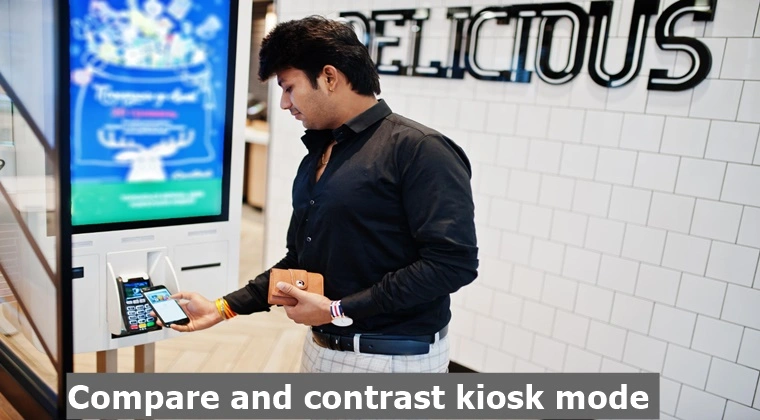Compare and contrast kiosk mode with other device management solutions

In today’s digital world, Mobile Device Management (MDM) software plays an important role in managing employees' personal or corporate mobile devices used for performing business operations to remain secure and competitive. MDM solutions are essential for organizations and businesses to carry out their daily life operations.
Kiosk mode is one of the most popular features of MDM software that secures digital devices without compromising their usability. You don’t have to wait in line for the other apps to close so that you can perform the function that you intend to. You won’t be stuck at the same page for hours. Now, your customers can enjoy hustle-free services where they can come and use the devices without any interference.
Not only that, business can use kiosk mode for data management, privacy and security measures, data organization, employee management and what not. Kiosk mode also help you in ensuring cybersecurity for your business. But, if you are still confused if you should opt for it, let’s compare it with the other options that you might consider.
Comparison of Kiosk Mode with Other Device Management Solutions
The following is the comparison of the kiosk mode features with other similar products to discuss their strengths and weaknesses.
Device lockdown
This software limits the functionality of a mobile device to a pre-defined group of applications and settings. It is useful for enterprises that just want to restrict their employees to access some functions or features while blocking all others such as social media, camera, or web browsers.
This software is simple to use and can be implemented efficiently. However, it is infeasible for situations where an organization requires granular control over device functionality or a higher customization level. In contrast, the kiosk feature offered by the MDM solution provides the flexibility to customize device functionality by limiting access to some specific settings and features.
App management
This feature allows IT admins to manage the apps installed on the mobile devices of employees. This software helps in managing the installation of new apps, deleting unnecessary apps, or updating existing ones. It is ideal for corporates that require employees to use approved apps.
However, the solution does not provide strong security mechanisms and hence cannot prevent users from accessing confidential information through different means including web browsers or other built-in features of a device. Kiosk mode provides a comparatively more detailed methodology to restrict the functionality of a device to one or a bunch of approved apps.
Mobile Application Management (MAM)
It allows IT teams to manage apps installed on employee devices securely. It enables admins to push, remove and update apps and enforce policies to control access of apps to device resources and other functionalities.
However, unlike kiosks, MAM is incapable of providing control of the entire device such as peripheral controls, hardware options, and operating system functionality. Therefore, it is not suitable for the public-facing kiosk.
Mobile Threat Defense (MTD) and Mobile Identity Management (MIM)
Both of these solutions are focused on improving the security posture of an organization by enforcing threat detection and prevention mechanisms coupled with authorization and authentication measures. Such software aims to secure the sensitive data of an organization in real time by avoiding unauthorized access.
In contrast, the scope of kiosk mode offered by the MDM solution is wide as it is capable of setting policies to control unauthorized access and ensures the protection of sensitive data by limiting users to certain approved apps and features. In this scenario, the user cannot misuse a device by any means.
Unified Endpoint Management (UEM)
It provides a unified console to manage the whole lifecycle of mobile devices from provisioning to configuration and then deals with security and compliance issues as well. Nevertheless, UEM solutions require additional configuration and setup and therefore are quite complicated to use compared to kiosk mode.
Moreover, kiosk mode is a practical solution for specific scenarios where a device is to be used for a specific purpose and thus needs to be locked down, for instance, in a hospitality or retail setting. In these scenarios, Kiosk mode is an ideal solution as it requires minimal configurations and provides an easy-to-use interface.
|
MDM Solution |
Advantages |
Limitations |
How Kiosk Mode is Better |
|
Device Lockdown |
Simple to use and deploy |
Limited customization and granular control |
Provides flexibility to customize device functionality by restricting access to certain features and settings |
|
App Management |
Focuses on managing app installation and usage |
May not prevent users from accessing sensitive data through other means |
It offers a more comprehensive approach by restricting device functionality to a single app or set of apps |
|
Mobile Threat Defense (MTD) |
Detects and prevents mobile device security threats |
May not provide granular control over device functionality |
Offers flexibility and customization to restrict access to certain features and settings |
|
Mobile Application Management (MAM) |
Focuses on managing the lifecycle of mobile applications |
May not provide comprehensive control over device functionality |
A holistic approach to device management by controlling access to some approved features and settings on the device |
|
Mobile Identity Management (MIM) |
Provides secure authentication and authorization for mobile devices |
May not provide granular control over device functionality |
Offers a higher level of customization and flexibility to lock down access to certain features and settings on the device |
|
Unified Endpoint Management (UEM) |
Provides a centralized console for managing all endpoints |
May be more complex to deploy and use compared to other solutions |
Provides a customizable and flexible approach to manage devices by restricting access to specific settings and |